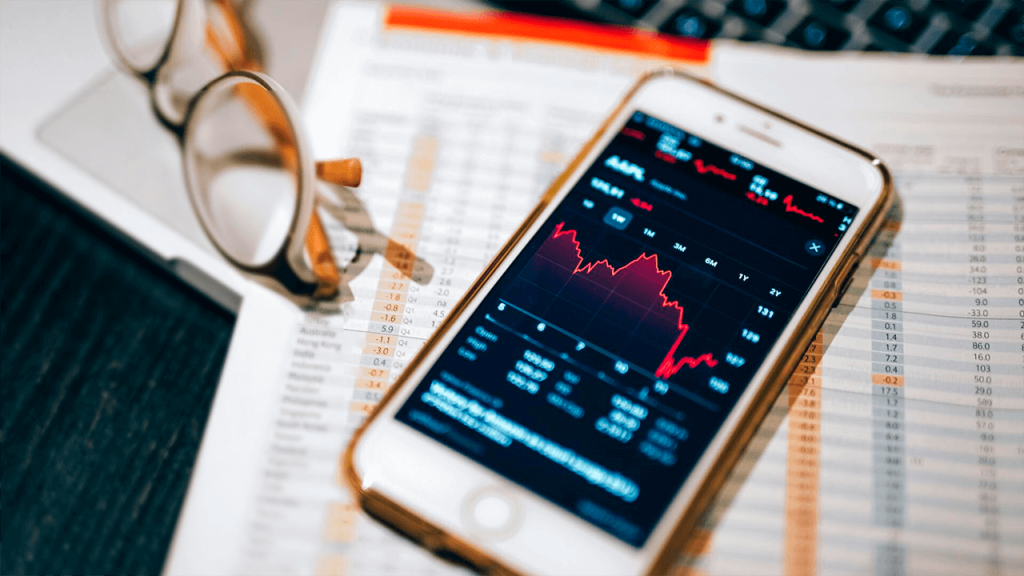In the stock market, supply and demand work together to determine the price of stocks and bonds. For beginners, the whole process can seem complicated, but if you understand the terminology, you can make confident investment decisions. In this article, we use figures, data, and real-world examples to cover the basic concepts of the stock market that every investor should know.
What are stocks and why are they the most important part of the stock market?
In the context of stock market basics, stocks are securities that give their owners a stake in a company and the right to a share of its profits in the form of dividends. An example of this is stocks of Apple (AAPL) or Tesla (TSLA).
The price of a stock depends on many factors. In 2023, Apple’s stock price fluctuated between $130 and $180, and Tesla’s stock price occasionally exceeded $400 per share. Value changes with company reports, foreign economic conditions, and market reactions to news.
There are two main sources of income when investing in stocks:
- Capital growth occurs when the price of a stock increases. Amazon (AMZN) has increased by 75% in the past five years, reflecting investors’ positive outlook on the company’s future earnings.
- Dividends are regular payments on securities. For example, Microsoft paid a dividend of $2.48 per share in 2023, which, at a stock price of around $300, equates to a return of 0.83% per year.
- When choosing which stocks to invest in, it is important to consider not only the current value of the company, but also its growth prospects and financial parameters, such as profitability and earnings.
Bonds: What You Need to Know to Minimize Risk
 Bonds are the second important term when it comes to the stock market. They are debt instruments that allow investors to earn a fixed income. When you buy a bond, you are essentially lending money to a company or government and receiving interest on it.
Bonds are the second important term when it comes to the stock market. They are debt instruments that allow investors to earn a fixed income. When you buy a bond, you are essentially lending money to a company or government and receiving interest on it.
Examples of this type of instrument are US government bonds, which are considered the safest on the market. Yields in 2023 ranged from 3% for 10-year bonds to 5.5% for shorter maturities.
Budget:
- The yield is the interest that a bond earns.
- The face value is the amount you receive when you pay off the bond. Typically, the face value is $1,000.
- Redemption is the process by which the amount of the debt is settled. For example, if you invest in an instrument with a 10-year maturity, you will receive a payout after 10 years.
When analyzing bonds, it is important to consider the creditworthiness of the issuer. For example, AAA options on large countries or companies are considered more reliable than BB or CCC options, which carry greater risk.
Bond market and trading: how to integrate them into your portfolio
Bond trading involves buying and selling these debt instruments with the aim of making a profit from changes in their value. This market is more stable than the stock market, but its dynamics are also subject to changes in interest rates.
For example, the yield on US 10-year government bonds was still 1.5 percent in 2022, but rose to 4 percent in mid-2023, leading to a fall in the prices of low-yield bonds.
The special thing about this market is that its value is highly dependent on changes in interest rates. When prices rise, they fall. This is because new bonds with higher interest rates become more attractive to investors, while older bonds with lower interest rates fall in value.
To properly use bonds in your portfolio, it is important to monitor market developments and diversify your investments across different types of instruments: government bonds, municipal bonds and corporate bonds.
Stock Market and Brokers: How to Choose the Right Players for Successful Investments
To successfully trade in the stock market, it is important to choose a broker that offers access to the stock market and the necessary trading instruments.
In 2023, Interactive Brokers, Charles Schwab and Fidelity are the leading brokers for investors. They offer low fees and access to a wide range of funds and stocks. At Interactive Brokers, trading fees can be as low as $0.005 per share, while at larger providers they can be as high as $7.
Unlike simple discount brokers, full-service brokers offer a wider range of services, including consulting, portfolio support and tax planning.
When selecting an agent, you should consider the following:
- Commission rates: These can have a significant impact on your overall profitability.
- Educational materials: Educational materials and analyses are useful for potential investors.
- Availability of instruments: Check whether access is offered to a wide range of securities and trading platforms.
Other Stock Market Terms Every Investor Should Know
In addition to basic terms like stocks and bonds, investors will encounter other stock market-related terms, such as margin trading and leverage.
Margin trading allows you to use borrowed money to buy stocks. For example, if you have $10,000 and want to buy $30,000 worth of stocks, the broker will offer you 3:1 leverage. This can increase your potential profit, but it also increases risk.
Another important concept is shareholder rights. This can include voting rights at general meetings of shareholders or participating in initial public offerings (IPOs).
Conclusion
 To successfully invest, it is important not only to understand the basics of the stock market, but also to be able to adapt it to your own strategy. By creating a diversified portfolio that combines stocks, bonds, and other assets, you can minimize risk and increase returns.
To successfully invest, it is important not only to understand the basics of the stock market, but also to be able to adapt it to your own strategy. By creating a diversified portfolio that combines stocks, bonds, and other assets, you can minimize risk and increase returns.
Do not forget the main principles: periodic market analysis, long-term planning and adapting your strategy to changes in the external environment. Investing in the stock market is not simply a routine process of buying and selling assets; it also requires careful planning, analysis and a strategic approach.



 Receiving dividends is one of the main ways to generate passive income through stock investments. Companies that pay out dividends regularly attract investors looking for a regular income. For example, the largest Russian companies pay out a dividend of 6% to 10% annually. When it comes to payment stability, the energy and metals sectors are leaders.
Receiving dividends is one of the main ways to generate passive income through stock investments. Companies that pay out dividends regularly attract investors looking for a regular income. For example, the largest Russian companies pay out a dividend of 6% to 10% annually. When it comes to payment stability, the energy and metals sectors are leaders. Investing in securities offers the opportunity to increase capital, but also carries the risk of capital loss. A balanced approach and careful analysis will help you understand whether stocks are worth buying in 2024. These instruments are suitable for anyone who is willing to take risks and achieve high returns.
Investing in securities offers the opportunity to increase capital, but also carries the risk of capital loss. A balanced approach and careful analysis will help you understand whether stocks are worth buying in 2024. These instruments are suitable for anyone who is willing to take risks and achieve high returns.
 The stock exchange is a platform where transactions for the purchase and sale of securities take place. A stock exchange (such as the Moscow Stock Exchange) provides the infrastructure for such transactions, and brokerage services help investors access transactions. The latter act as an intermediary between the exchange and the investor, providing trading platforms and analysis tools. When choosing a broker, it is important to consider the cost, reliability, and availability of licenses to minimize risks and reduce costs.
The stock exchange is a platform where transactions for the purchase and sale of securities take place. A stock exchange (such as the Moscow Stock Exchange) provides the infrastructure for such transactions, and brokerage services help investors access transactions. The latter act as an intermediary between the exchange and the investor, providing trading platforms and analysis tools. When choosing a broker, it is important to consider the cost, reliability, and availability of licenses to minimize risks and reduce costs. Making money with stocks is a real way to achieve financial freedom and protect your capital from inflation. Whether you are a beginner or an experienced investor, it is important to remember that careful analysis and smart strategy selection are essential. First, choose a reliable broker, research the market, define your goals and take action.
Making money with stocks is a real way to achieve financial freedom and protect your capital from inflation. Whether you are a beginner or an experienced investor, it is important to remember that careful analysis and smart strategy selection are essential. First, choose a reliable broker, research the market, define your goals and take action.
 Bank shares are not only a source of regular dividend payments, but also offer a real opportunity for capital growth. As the economy grows, many banks are seeing the value of their shares increase, making them an attractive investment for long-term investors. For example, Sberbank and Tinkoff shares recorded an average annual growth of 10-15%, significantly outperforming inflation and outperforming many other instruments. Tinkoff shares rose by 25% in 2021, and the company’s share price has almost quadrupled since 2016.
Bank shares are not only a source of regular dividend payments, but also offer a real opportunity for capital growth. As the economy grows, many banks are seeing the value of their shares increase, making them an attractive investment for long-term investors. For example, Sberbank and Tinkoff shares recorded an average annual growth of 10-15%, significantly outperforming inflation and outperforming many other instruments. Tinkoff shares rose by 25% in 2021, and the company’s share price has almost quadrupled since 2016. Investing in bank shares is a promising option for those looking for stability and dividends. It is important to understand both the benefits and risks of such investments. An expert approach to stock and broker selection, regular analysis of financial indicators and understanding of regulatory risks will help you minimize risk and maximize profits. May this path be the first step toward financial independence and confidence in the future.
Investing in bank shares is a promising option for those looking for stability and dividends. It is important to understand both the benefits and risks of such investments. An expert approach to stock and broker selection, regular analysis of financial indicators and understanding of regulatory risks will help you minimize risk and maximize profits. May this path be the first step toward financial independence and confidence in the future.
 There are numerous tools available to facilitate your analysis. For example, websites like Yahoo Finance and TradingView provide access to vast amounts of data that can help beginners choose the right stocks for their investments. Market research is like a game of chess: the more you know, the easier it is to move in the right direction.
There are numerous tools available to facilitate your analysis. For example, websites like Yahoo Finance and TradingView provide access to vast amounts of data that can help beginners choose the right stocks for their investments. Market research is like a game of chess: the more you know, the easier it is to move in the right direction. Investing in securities is a long-term process that requires patience and a thoughtful approach. How to invest successfully in stocks? The answer is simple: set long-term goals, don’t panic about market fluctuations, and keep learning. Investing won’t make you rich overnight, but with the right approach, you can build a solid foundation for financial independence.
Investing in securities is a long-term process that requires patience and a thoughtful approach. How to invest successfully in stocks? The answer is simple: set long-term goals, don’t panic about market fluctuations, and keep learning. Investing won’t make you rich overnight, but with the right approach, you can build a solid foundation for financial independence.
 For newcomers to the stock market, it is important to opt for investments from stable institutions. These are lower-risk instruments that gradually provide insight into the nuances of the market. These include securities from companies with high capitalization and a long payment history.
For newcomers to the stock market, it is important to opt for investments from stable institutions. These are lower-risk instruments that gradually provide insight into the nuances of the market. These include securities from companies with high capitalization and a long payment history. Investeren in aandelen is een strategie voor de lange termijn die, indien goed aangepakt, u in staat stelt uw kapitaal te laten groeien en financiële stabiliteit te bereiken. U kunt klein beginnen: open een beleggingsrekening, selecteer een aantal betrouwbare beleggingen en bouw geleidelijk uw portefeuille op. De sleutel tot succesvol beleggen is het nemen van slimme beslissingen, deze regelmatig evalueren en openstaan voor verandering.
Investeren in aandelen is een strategie voor de lange termijn die, indien goed aangepakt, u in staat stelt uw kapitaal te laten groeien en financiële stabiliteit te bereiken. U kunt klein beginnen: open een beleggingsrekening, selecteer een aantal betrouwbare beleggingen en bouw geleidelijk uw portefeuille op. De sleutel tot succesvol beleggen is het nemen van slimme beslissingen, deze regelmatig evalueren en openstaan voor verandering.